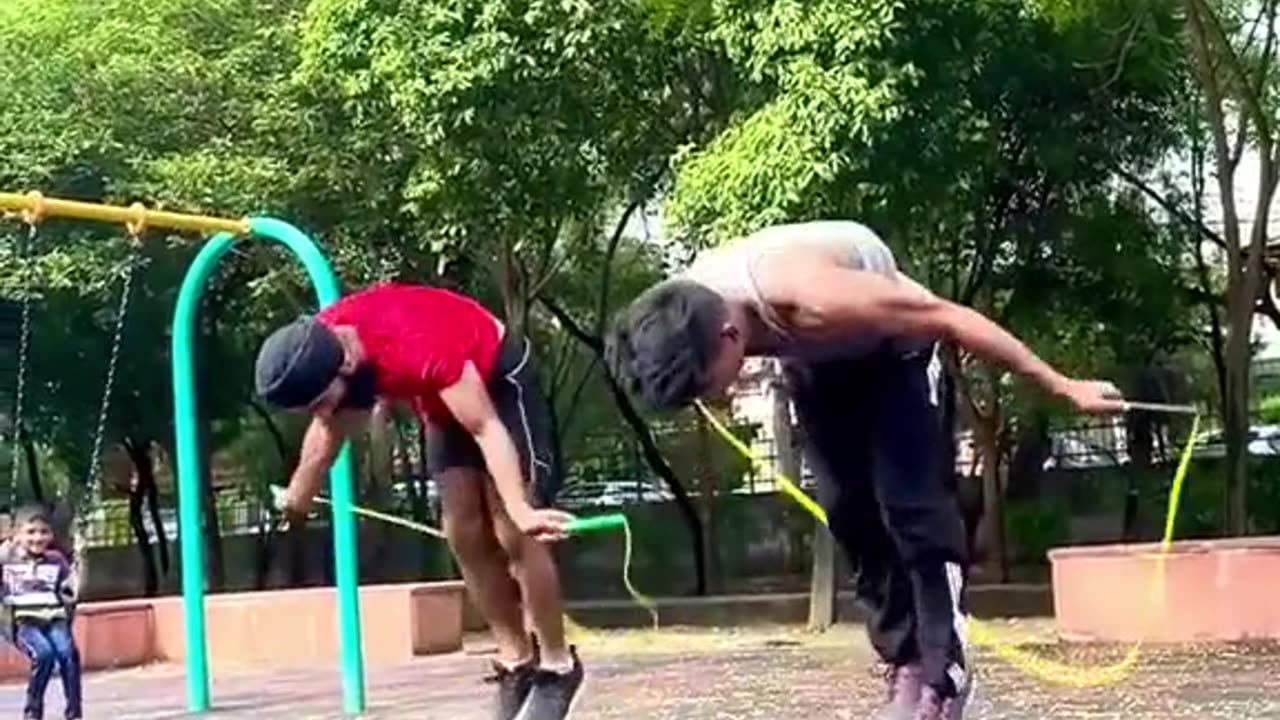Premium Only Content

Amazing Skills 😁💯👏
Rope jumping, also known as skipping or jump rope, is a popular cardiovascular exercise and a form of physical activity that involves jumping over a rope while it swings beneath your feet and over your head. It can be done as a solo activity or with others in a group.
Rope jumping offers several benefits for overall fitness and health, including:
Cardiovascular fitness: Jumping rope is a great aerobic exercise that gets your heart rate up, improving cardiovascular health and stamina.
Coordination and agility: Rope jumping requires coordination between your hands and feet, improving your motor skills, balance, and agility.
Full-body workout: It engages multiple muscle groups, including your legs, core, arms, and shoulders. Regular rope jumping can help tone and strengthen these muscle groups.
Weight management: Jumping rope burns calories effectively, which can contribute to weight loss or weight management when combined with a balanced diet.
Portable and affordable: Jump ropes are inexpensive and portable, making it a convenient exercise option that can be done almost anywhere, indoors or outdoors.
When getting started with rope jumping, here are a few tips to keep in mind:
Choose the right rope: Select a rope that is appropriate for your height. Stand on the middle of the rope, and the handles should reach your armpits.
Maintain proper form: Stand with your feet together and hold the handles firmly in each hand. Keep your elbows close to your sides and use your wrists to rotate the rope.
Start slowly: Begin with a slower pace and gradually increase your speed as you become more comfortable and proficient. Focus on developing a smooth rhythm.
Land softly: Jump just high enough to clear the rope. Land on the balls of your feet with your knees slightly bent to absorb the impact and reduce strain on your joints.
Mix up your routines: Vary your jumping techniques, such as alternating between single jumps, double unders (two rotations of the rope per jump), or crisscrossing your arms, to challenge yourself and prevent boredom.
Remember to warm up before starting and cool down afterward to prevent injuries. If you have any underlying health conditions or concerns, it's advisable to consult with a healthcare professional before starting any new exercise routines
-
 1:41:05
1:41:05
Tundra Tactical
6 hours ago $2.95 earnedGive Us Your Best Gun Questions!!! Chat Night On The Worlds Okayest Gun Live Stream
16.3K1 -
 DVR
DVR
BlackDiamondGunsandGear
4 hours ago🔴Gear Know How / HPA/ & DLD AFTER DARK
4.43K2 -
 2:11:11
2:11:11
DLDAfterDark
2 hours ago $7.58 earnedDLD Live! Gun Talk - Welcome To The Armory - Feat. BDG&G
21.3K2 -
 47:14
47:14
The Connect: With Johnny Mitchell
14 hours ago $2.80 earnedMeet The Cartel Hunters At WAR With New Zeta Drug Cartel- Mexico's Most Violent Criminal Empire
42.7K4 -
 38:10
38:10
Stephen Gardner
2 days agoI can't BELIEVE Trump DID THIS! Jill Biden ACCUSED of MAJOR CRIME!
44.8K90 -
 14:50
14:50
Russell Brand
11 hours agoJoe Rogan Goes Into SHOCK As Guest Exposes Government MIND CONTROL
54.9K81 -
 31:59
31:59
The Brett Cooper Show
12 days ago $7.26 earnedBernie Fights Oligarchy From His Private Jet & Prince Harry’s Biggest L Yet | Episode 30
35.5K29 -
 20:23
20:23
Exploring With Nug
14 hours ago $7.81 earnedI Found Something DISTURBING Thrown Off The Bridge!
206K9 -
 26:24
26:24
MYLUNCHBREAK CHANNEL PAGE
1 day agoMilitary Sites STOLE the Old World - Pt 1
146K72 -
 4:15:08
4:15:08
MissesMaam
6 hours agoRumblers Actin' Sus | Lockdown Protocol 💚✨
28.7K3